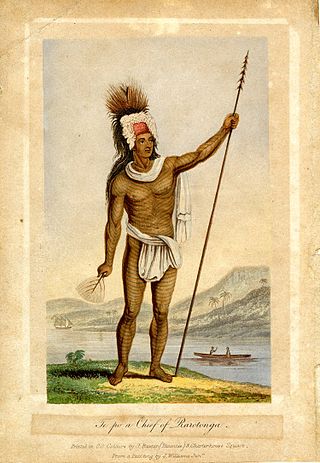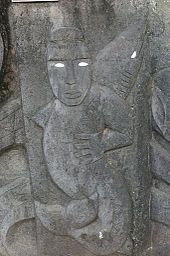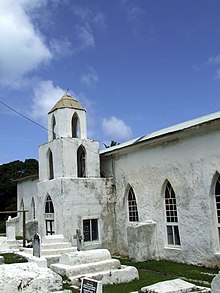
The Cook Islands is an island country in Polynesia, part of Oceania in the South Pacific Ocean. It consists of 15 islands whose total land area is approximately 236.7 square kilometres (91 sq mi). The Cook Islands' Exclusive Economic Zone (EEZ) covers 1,960,027 square kilometres (756,771 sq mi) of ocean. Avarua is its capital.

The Cook Islands are named after Captain James Cook, who visited the islands in 1773 and 1777, although Spanish navigator Alvaro de Mendaña was the first European to reach the islands in 1595. The Cook Islands became aligned to the United Kingdom in 1890, largely because of the fear of British residents that France might occupy the islands as it already had Tahiti.
Demographic features of the population of the Cook Islands include population density, ethnicity, education level, health of the populace, economic status, religious affiliations and other aspects of the population.

Like most countries and territories in Oceania, telecommunications in the Cook Islands is limited by its isolation and low population, with only one major television broadcasting station and six radio stations. However, most residents have a main line or mobile phone. Its telecommunications are mainly provided by Telecom Cook Islands, who is currently working with O3b Networks, Ltd. for faster Internet connection.
In Polynesian languages the word aitu refers to ghosts or spirits, often malevolent. The word is common to many languages of Western and Eastern Polynesia. In the mythology of Tonga, for example, ʻaitu or ʻeitu are lesser gods, many being patrons of specific villages and families. They often take the form of plants or animals, and are often more cruel than other gods. These trouble-making gods are regarded as having come from Samoa. The Tongan word tangi lauʻaitu means to cry from grief, to lament.

In Cook Islands mythology, Avatea was a lunar deity and the father of gods and men in Mangaian myth of origin. His eyes were thought to be the Sun and the Moon; he was also known as the god of light.

Rarotonga is the largest and most populous of the Cook Islands. The island is volcanic, with an area of 67.39 km2 (26.02 sq mi), and is home to almost 75% of the country's population, with 10,898 of a total population of 15,040. The Cook Islands' Parliament buildings and international airport are on Rarotonga. Rarotonga is a very popular tourist destination with many resorts, hotels and motels. The chief town, Avarua, on the north coast, is the capital of the Cook Islands.

John Williams was an English missionary, active in the South Pacific.

Penrhyn is an atoll in the northern group of the Cook Islands in the south Pacific Ocean. The northernmost island in the group, it is located at 1,365 km (848 mi) north-north-east of the capital island of Rarotonga, 9 degrees south of the equator. Its nearest neighbours are Rakahanga and Manihiki, approximately 350 kilometres (220 mi) to the southwest. Once one of the most heavily populated atolls, it was almost completely depopulated by Peruvian slavers in 1864.
Cook Islands Māori is an Eastern Polynesian language that is the official language of the Cook Islands. Cook Islands Māori is closely related to New Zealand Māori, but is a distinct language in its own right. Cook Islands Māori is simply called Māori when there is no need to disambiguate it from New Zealand Māori, but it is also known as Māori Kūki ʻĀirani or, controversially, Rarotongan. Many Cook Islanders also call it Te reo Ipukarea, literally "the language of the Ancestral Homeland".

The London Missionary Society was an interdenominational evangelical missionary society formed in England in 1795 at the instigation of Welsh Congregationalist minister Edward Williams. It was largely Reformed in outlook, with Congregational missions in Oceania, Africa, and the Americas, although there were also Presbyterians, Methodists, Baptists, and various other Protestants involved. It now forms part of the Council for World Mission.

Aaron Buzacott the elder was a British missionary, Congregationalist colleague of John Williams, author of ethnographic works and co-translator of the Bible into Cook Islands Māori. Buzacott was a central figure in the South Seas missionary work of the London Missionary Society, and lived on Rarotonga from 1828 to 1857. During his time there, he assisted in the development of the written form of Cook Islands Māori, compiling a primer on English and Cook Islands Maori grammar. Buzacott, along with Williams and other missionary colleagues, contributed to the first translation of the Bible into that language, and translated additional theological texts including lectures from his education in London.

The Cook Islands Christian Church (CICC) is the largest religious denomination in the Cook Islands. It belongs to the Reformed family of churches. The CICC is a Christian Congregationalist church and has approximately 18,000 members, including around half of the residents of the Cook Islands. The church also has congregations in New Zealand and Australia.
Ronald Gordon Crocombe was a Professor of Pacific Studies at the University of the South Pacific. His reputation was such that he was described as the "father of Pacific Studies".

Makea Takau Ariki was a sovereign of the Cook Islands. She was the ariki (queen) of the dynasty Makea Nui, one of the three chiefdoms of the tribe Te Au O Tonga on the island of Rarotonga.
Te Ariki Terau Mana Strickland BEM was a Cook Island educator and politician. He was the Minister of Education in the first Cook Islands government after self-government was obtained in 1965.

Pa Maretu Ariki was a sovereign of the Cook Islands. He was the ariki of the Pa dynasty, one of the two chiefdoms of the Takitumu tribe on the island of Rarotonga.

Cook Islands mythology comprises historical myths, legends, and folklore passed down by the ancient Cook Islanders over many generations. Many of the Cook Islands legends were recited through ancient songs and chants. The Cook Islands myths and legends have similarities to general Polynesian mythology, which developed over the centuries into its own unique character.

The culture of the Cook Islands reflects the traditions of its fifteen islands as a Polynesian island country, spread over 1,800,000 square kilometres (690,000 sq mi) in the South Pacific Ocean. It is in free association with New Zealand. Its traditions are based on the influences of those who settled the islands over several centuries. Polynesian people from Tahiti settled in the Cook Islands in the 6th century. The Portuguese captain, Pedro Fernandes de Queirós, made the first recorded European landing in the islands in the early 17th century, and well over a hundred years later, in the 18th century, the British navigator, Captain James Cook arrived, giving the islands their current name. Missionaries developed a written language, bringing schools and Christianity to the Cook Islands in the early 19th century. Cook Islands Māori, also known as Māori Kūki 'Āirani or Rarotongan, is the country's official language.
Glassie Davy George Strickland was a Cook Islands missionary, businessman and politician. He served as a member of the Legislative Assembly between 1958 and 1961.














